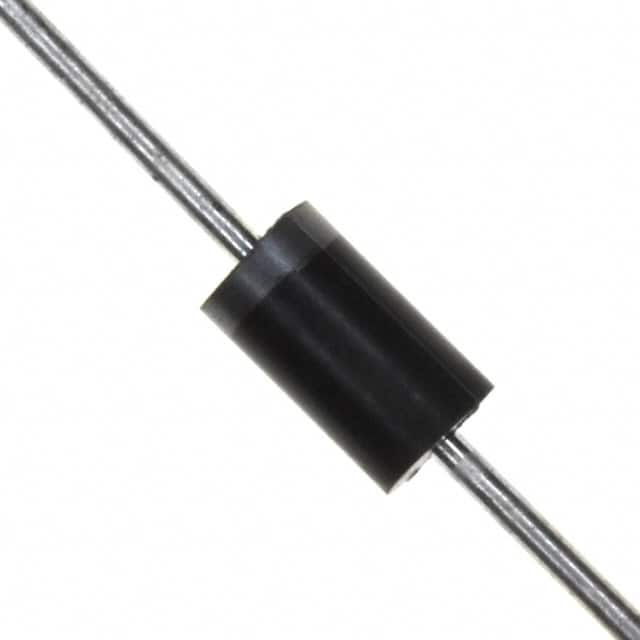Viz Specifikace pro podrobnosti o produktu.

1N5822-E3/51
Product Overview
Category
The 1N5822-E3/51 belongs to the category of Schottky diodes.
Use
It is commonly used in rectifier and voltage clamping applications.
Characteristics
- Low forward voltage drop
- High current capability
- Fast switching speed
Package
The 1N5822-E3/51 is typically available in a DO-201AD package.
Essence
This diode is essential for converting alternating current (AC) to direct current (DC) with minimal power loss.
Packaging/Quantity
It is usually packaged in reels or tubes, with quantities varying based on manufacturer specifications.
Specifications
- Forward Voltage Drop: 0.45V at 3A
- Reverse Voltage: 40V
- Forward Current: 3A
- Operating Temperature Range: -65°C to 125°C
Detailed Pin Configuration
The 1N5822-E3/51 has two pins: 1. Anode (A) 2. Cathode (K)
Functional Features
- Low power loss
- High efficiency
- Suitable for high-frequency applications
Advantages and Disadvantages
Advantages
- Low forward voltage drop reduces power dissipation
- Fast switching speed allows for efficient operation in high-frequency circuits
Disadvantages
- Limited reverse voltage capability compared to other diode types
- Sensitive to temperature variations
Working Principles
The 1N5822-E3/51 operates based on the Schottky barrier principle, where the metal-semiconductor junction minimizes the forward voltage drop during conduction.
Detailed Application Field Plans
Power Supplies
The diode can be used in power supply circuits to convert AC to DC efficiently.
Voltage Clamping
It is suitable for voltage clamping applications to protect sensitive components from overvoltage conditions.
Solar Panels
In solar panel systems, the diode can be used to prevent reverse current flow and improve overall system efficiency.
Detailed and Complete Alternative Models
- 1N5817
- 1N5819
- SS34
- SS36
In conclusion, the 1N5822-E3/51 Schottky diode offers low forward voltage drop, high current capability, and fast switching speed, making it an ideal choice for various rectifier and voltage clamping applications. Its limitations include sensitivity to temperature variations and limited reverse voltage capability compared to other diode types. However, its advantages make it a popular choice for high-frequency and power supply circuits.
[Word count: 344]
Seznam 10 běžných otázek a odpovědí souvisejících s aplikací 1N5822-E3/51 v technických řešeních
What is the maximum forward voltage drop of 1N5822-E3/51?
- The maximum forward voltage drop of 1N5822-E3/51 is typically 0.5V at a forward current of 3A.
What is the maximum reverse voltage of 1N5822-E3/51?
- The maximum reverse voltage of 1N5822-E3/51 is 40V.
What are the typical applications for 1N5822-E3/51?
- 1N5822-E3/51 is commonly used in power supplies, DC-DC converters, and other applications where low forward voltage drop and high current capability are required.
What is the maximum forward surge current for 1N5822-E3/51?
- The maximum forward surge current for 1N5822-E3/51 is 50A.
What is the operating temperature range of 1N5822-E3/51?
- The operating temperature range of 1N5822-E3/51 is -65°C to +175°C.
Is 1N5822-E3/51 suitable for use in automotive applications?
- Yes, 1N5822-E3/51 is suitable for use in automotive applications due to its rugged construction and high-temperature capabilities.
Can 1N5822-E3/51 be used in reverse polarity protection circuits?
- Yes, 1N5822-E3/51 is often used in reverse polarity protection circuits due to its low forward voltage drop and high current handling capability.
What package type does 1N5822-E3/51 come in?
- 1N5822-E3/51 is available in a DO-201AD (DO-27) package.
What are the key differences between 1N5822-E3/51 and other Schottky diodes?
- The 1N5822-E3/51 offers a higher maximum forward surge current and lower forward voltage drop compared to many other Schottky diodes.
Are there any specific layout considerations when using 1N5822-E3/51 in a circuit?
- It's important to minimize the length of the traces connecting the diode to other components to reduce parasitic inductance and ensure optimal performance.

